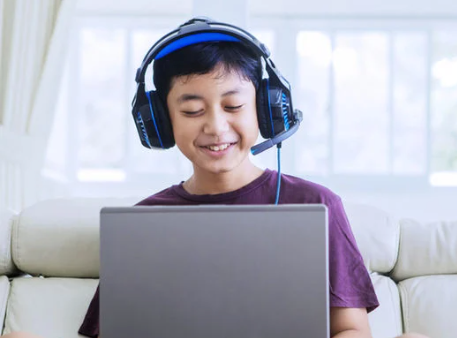Key points
-
Screen time can be part of a healthy lifestyle when balanced with other activities that are good for school-age development.
-
Physical play, creative play, reading, socialising, and sleep is important for school-age development.
-
Family rules can help you balance screen time and other activities for school-age children. Use our free template.
-
Alternative options for controlling screen time at home.

WHY DO WE NEED TO MANAGE OUR SCREEN TIME?
It’s common knowledge that the use of screens can impact our health, both physically and mentally. However, it isn’t a case of screen = bad and no-screen = good. It’s how we use our screens and what we use them for that determines whether they have a positive or negative impact on our lives.
So what is good and what is bad about what most people consider “screen time”?
SITTING DOWN FOR LONG PERIODS = BAD
Sitting down in the wrong position for long periods can lead to strains, pains, and bad posture. The solution to this is to ensure regular breaks and that you are sitting in the correct position. On our courses, we encourage good sitting positions by using age-appropriate chairs and equipment. We also make sure the children take regular breaks to give their backs and necks rest.
Our Holiday camps are based at locations with outdoor play facilities and our recent residential to Sayers Croft was an even split between fast-paced outdoor activities and screentime. Even some of our coding activities took place outdoors.

WORK, PLAY, AND SOCIALISING
Our children use screens in many of the same ways that we do:
-
At work, you likely collaborate on projects online whilst in a team. Our children do this at school and clubs/camps.
-
65% of adults are gamers. I expected this to be higher and it definitely will be when our children are adults as almost all of them are gamers.
-
We all use messaging services such as Whatsapp to keep in touch with friends. Recently we have also been using Zoom and other platforms to socialise. Our children use Xbox Live and PSN (Playstation Network) among others to keep in contact with each other.
One of the best parts of our holiday camps is the social element. Children are coding or playing whilst being able to socialise with their friends in the same room. It makes our competitive Minecraft days quite intense! The difference between gaming at our camps versus at home is that your child knows the person they are playing against and there is a teacher right there to regulate any communication.
What your child is doing whilst on the screen is also very important. Are they mindlessly playing a game or are they working as part of a team to build something incredible? I witness this all of the time on our courses. A group of 4 or 5 children will construct a virtual hotel together, each has a set list of jobs and all have agreed on a specification that they will need to follow. How can screentime like this be bad? The truth is, it isn’t. It is creative, collaborative, and extremely fun.
IMPROVING SCREEN TIME AT HOME
This is a question we get asked all of the time and I try to focus on what will have the biggest impact when giving advice on this topic. The best tool is a family agreement. I have put together a template that you can download by clicking here.

Making a family agreement is a great way to decide as a family how much time you will spend on devices. Together you can come up with rules that all members of the family agree to, this can include things such as no devices at mealtimes or no screen time before bed. Use our template or make your own together with your child.
A family agreement is great because it feels less like a set of rules and more like a contract that both parties agree to. You agree to allow screentime and in return, they will use it only when allowed and only on the platforms/games that you agree to. Essentially, you’re still in complete control but they have it in writing what they can and can’t do and where and when they can or can’t do it.
A family agreement is by far the best solution but if you can’t make it work then there are alternative methods. In my household, we have purchased a ‘mesh wi-fi’ system. There are plenty out there on the market and most come with an app that allow you to control what devices have access to the Internet.
We chose to go with Amazon’s own Eero system. On the app, I can set up profiles and say which devices are owned by who. My 1-year-old isn’t exactly pushing the boundaries just yet but when he is older I will be able to turn his Internet off with a few taps on my smartphone. I can also set up a schedule.
Alternatively, there are paid-for apps such as ‘OurPact‘. I haven’t experimented with them myself but I have heard good things and there is plenty of options out there. I personally prefer a physical solution such as our Eero network but these apps will likely work just as well.
Finally, if you want to go old school. You could just take the device or power lead away from them or turn off your Internet router at the plug. Both of those options will work pretty well!







